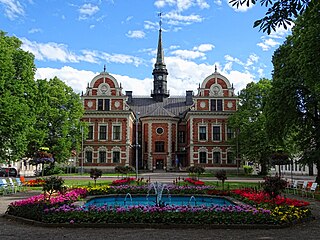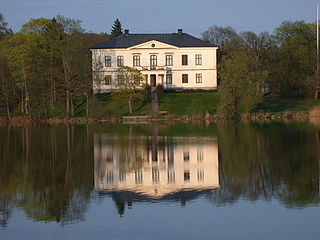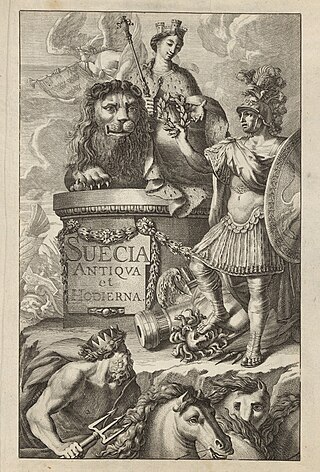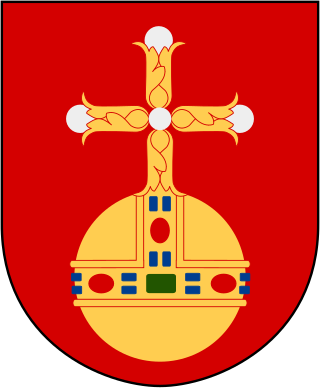Related Research Articles

Count Erik Jönsson Dahlbergh was a Swedish military engineer, Governor-general and Field marshal. He rose to the level of nobility through his military competence. According to Cathal Nolan, Count Dahlberg was a highly innovative military engineer in the 17th and 18th century, often referred to as the "Swedish Vauban". He was expert in both building and destroying fortifications. In warfare he won several sieges, including Copenhagen and Kronborg. He famously led a Swedish army across the frozen Great and Little Belts to attack Copenhagen. Dahlberg commanded Swedish engineers in several wars and his historic influence was ensured vika his skill at map-making, the fortresses he designed, and his widely read writings on military architecture. Today he is well known through his Suecia Antiqua et Hodierna, a collection of engravings of topographical research.

Suecia Antiqua et Hodierna is a collection of engravings collected by Erik Dahlbergh during the middle of the 17th century. Suecia Antiqua et Hodierna can be described as a grand vision of Sweden during its period as a great power. Dahlberg's direct source of inspiration was the topographical publications issued by the Swiss publisher Matthäus Merian. In 1661 Dahlberg was granted a royal privilege enabling him to realize his plans, which kept him occupied for a good decade, and a work that would not be printed until after his death. In its final state Suecia Antiqua et Hodierna comprised three volumes containing 353 plates.
Hodierna is a feminine given name and a family name.

Falkenberg is a locality and the seat of Falkenberg Municipality, Halland County, Sweden, with 27,813 inhabitants in 2019. It is located at the mouth of river Ätran. The name consists of the Swedish words for falcon (falk) and mountain (berg). Falkenberg is a popular tourist destination in the summers, and the main beach of the town is Skrea strand.

Kalmar is a city in the southeast of Sweden, situated by the Baltic Sea. It had 36,392 inhabitants in 2010 and is the seat of Kalmar Municipality. It is also the capital of Kalmar County, which comprises 12 municipalities with a total of 236,399 inhabitants (2015). Kalmar is the third largest urban area in the province and cultural region of Småland.

Lidköping is a locality and the seat of Lidköping Municipality in Västra Götaland County, Sweden. It had about 40 000 inhabitants in 2021.

Söderhamn is a locality and the seat of Söderhamn Municipality, Gävleborg County, Sweden with 11,761 inhabitants in 2010.

Tre Kronor or Three Crowns Castle was a castle located in Stockholm, Sweden, on the site where Stockholm Palace is today. It is believed to have been a citadel that Birger Jarl built into a royal castle in the middle of the 13th century. The name "Tre Kronor" is believed to have been given to the castle during the reign of King Magnus IV in the middle of the 14th century.

Wrangel Palace is a townhouse mansion on Riddarholmen islet in Gamla Stan, the old town of Stockholm, Sweden.
André Mollet was a French garden designer, the son of Claude Mollet—gardener to three French kings—and the grandson of Jacques Mollet, gardener at the château d'Anet, where Italian formal gardening was introduced to France.

Charlottenborg is a manor house in Motala on the shores of Motala ström in Östergötland county, Sweden.
The history of Falkenberg is, to a smaller or larger extent, known since the late 13th century, when the town starts to appear in written sources. The town might have taken over the position as a local power center from a location in Stafsinge. It was then Danish, and would remain so up till 1645, with some minor interruptions. From the 14th century and on to the Northern Seven Years' War (1563-1570) a second town, Ny-Falkenberg was located close to the town. The fort from which the fiefdom had been run was destroyed by Engelbrekt Engelbrektsson's troops in 1434, and would not be rebuilt, hence marking the end of the fiefdom. The town gained its market rights in 1558.

Jan van den Aveele or Aveelen was a Dutch etcher and copper engraver.

Noor palace is a 14th-century mansion in Knivsta, Sweden.

Tureholm Castle is a privately owned castle in Trosa Municipality in Sweden. The castle was built in the 18th century, and is a listed building since 1987.

Willem Swidde was a Dutch draughtsman and engraver, active in Sweden.

Events from the year 1716 in Sweden

The helmet and spurs of Saint Olaf are the oldest preserved war trophies taken by Sweden. They were taken as loot in 1564 during the Northern Seven Years' War from Trondheim by Claude Collart, an army commander in service of Eric XIV of Sweden.

The coat of arms of Uppland in Sweden is Gules, an orb or. The coat of arms is surmounted by a duke's coronet, as are the other Swedish regional coats of arms.

Brunnsholm is an estate and former seat farm in Enköpings-Näs parish in Enköping municipality in Uppland, Sweden, located 12 kilometers southwest of Enköping.
References
- 1 2 Biblioteksbladet 1916: Litteratur om Halland (in Swedish)
- ↑ Tvärsnitt 2/2003: När forntiden blev ett vapen i maktens tjänst Archived 2007-09-28 at the Wayback Machine (in Swedish)